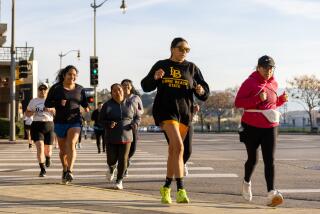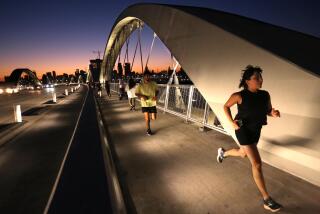Keep Running on the Road
- Share via
AFTER flying from Los Angeles to Sydney, Australia, Adam Hancock was tossing and turning in his hotel bed.
“I woke up at 3 a.m., Sydney time,” said Hancock, the director of film distribution for Buena Vista International in Burbank. His solution: Go for a run.
Some business travelers would have popped a sleeping pill and hoped for the best. But Hancock, a lifelong runner who logs 15 to 20 miles a week, decided it was a good time to squeeze in a workout.
When he found the hotel gym closed, he asked the staff to open it. They did, and he got his run.
Maintaining a running schedule or some semblance of it isn’t easy for business travelers coping with late flights, missed connections, time zone changes and differences in altitude, temperature and humidity.
But plenty of people do keep up a routine, and some even manage to train for long-distance events while on extended trips. How? With well-honed strategies, mental preparation and help from hotel concierges and local running associations.
The first step is to ignore time differences and jet lag, said Laszlo Tabori, a veteran running coach, former Olympian and the third man to log a sub-four-minute mile. Just fit in the run upon arrival at your destination, he said. During a recent trip to his native Hungary, Tabori put on his running gear as soon as he reached the hotel. “No shower first,” he said. “Just go.”
Schedule your connections to allow a run, suggested Laurence Grogin, a chiropractor and acupuncturist in Franklin Lakes, N.J. When flying from the East Coast to Los Angeles, “I deliberately have a connection in Dallas -- a 2 1/2-hour connection -- so I can go for an hour-and-a-half run,” he said. He leaves the terminal and runs for 45 minutes before turning around. “I sometimes coordinate with the Hilton and take a shower there,” he said.
Grogin also has combined his running with business, once scheduling a meeting at San Francisco’s Golden Gate Park with a potential sponsor of a fitness video he was creating. He and the sponsor ran five miles together.
“It was a wonderful meeting,” Grogin said.
Runners should make a mental commitment to exercise when they’re away on business, said Jeff Galloway, author and spokesman for the American Running Assn.
“You lay out the clothes and shoes,” he said. “You have the coffeepot ready to go or whatever your booster beverage is. As you lie down to go to sleep, you say to yourself, ‘Hit the alarm clock, feet on the floor, to the coffeepot.’ It’s repetitive.”
He believes that if you’re mentally committed to that routine, you have a 90% likelihood of getting up and running.
What about changes in altitude? Galloway suggested walking as a break from running. If you typically run 10 miles, try walking for one minute after each mile of running.
“Walk breaks diffuse the fatigue,” he said. Running in the correct clothes and at the right time of day can help travelers if temperatures and humidity are different from home.
To find the best routes in a strange city, ask the concierge. Hotels often have maps plotting routes and noting mileage. The Fairmont San Francisco provides a map that attaches like a wristwatch and shows a three-mile loop around the hotel and includes landmarks, spokeswoman Samara Diapoulos said.
Another tactic is to e-mail a running club at your destination, said Gerry Hans, a member of the Los Feliz Flyers running club in Los Angeles. He often gets e-mails from runners visiting Los Angeles, and he steers them to his favorite routes in Griffith Park.
To find a running club at your destination, visit the Road Runners Club of America website, www.rrca.org, and click on clubs. Then click on the map to get contact information. The Run the Planet website, www.runtheplanet.com, describes more than 3,200 places to run and walk in nearly 2,400 cities worldwide.
Sometimes the most memorable running routes may seem dismal. Mike Dimkich, a rhythm guitarist for the Cult, can attest. During the band’s tour that ended in spring 2001, the Woodland Hills musician was training for the Angeles Crest 100 Mile Endurance Run.
He was trying to run 80 or more miles a week despite playing gigs, staying up late and having to ride buses from one venue to the next.
In Birmingham, Ala., his hotel had no place to run except for a “crazy frontage road,” he said. “It was like running around a huge roundabout. It was the worst run ever.”
That said, Dimkich ran the same route over and over, and three years later he remembers that frontage road as a key to reaching his training goals.
*
(BEGIN TEXT OF INFOBOX)
Staying Fit ... and Safe
You’re in an unfamiliar city and itching for a run. Stay safe by following these tips from Kevin Coffey, a police detective and travel safety expert.
* If you are running alone, tell the hotel concierge or manager know where you are headed and how long you’ll be out. Check back with them when you return.
* Always carry identification. Shoe tags with your home address and phone aren’t as good as an ID card with emergency information, including a contact name and number and your blood type. In a pinch, write your name and room number on a card and stow it in your pocket or sock.
* Consider carrying a cellphone.
* If you’re unsure of a park’s safety, run its perimeter. You can sample its natural appeal while avoiding dangers that may lurk in secluded areas.
* Choose low-risk times to run. Anytime around or after dusk is more dangerous than daylight hours. In a city, run in the business district when large numbers of people are around.
* For more travel safety tips, see www.corporatetravelsafety.com.
More to Read
Sign up for The Wild
We’ll help you find the best places to hike, bike and run, as well as the perfect silent spots for meditation and yoga.
You may occasionally receive promotional content from the Los Angeles Times.






